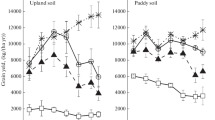Summary
The effect of crop production factors on the maize yield was studied on a chernozem soil with lime deposits at the Látókép Experimental Farm of the Department of Land use of the Debrecen Agricultural University between 1989 and 1994. A multifactorial long-term experiment made it possible to evaluate the effects and interactions of fertilization and soil cultivation. Soil cultivation can only be considered to be up-to-date and adaptable if it is adjusted both to soil status and to farming conditions. The method, tool and depth of cultivation must be chosen to suit the physical state of the soil. A consideration of the moisture content of the soil reduces damage to the soil structure.
The experimental results prove that on a chernozem soil, provided precipitation supplies are at least average, winter ploughing, even without fertilization or with low fertilizer rates, causes a substantial increase in the maize yield by making the soil nutrients available to the plant. The extra yield achieved with winter ploughing without fertilization was 1.4–2.3 t/ha compared to the unploughed variant. In fertilized treatments the yield increase was greater, averaging 2.8–3.3 t/ha. Over a six-year average, the yields were 0.6 t/ha lower after spring ploughing than after winter ploughing. In dry years the yield difference was somewhat smaller, but under favourable rainfall conditions maize grown after spring ploughing yielded 1.0-1.4 t/ha less than after winter ploughing.
Fertilization was able to compensate in part, but not entirely, for other unfavourable agrotechnical effects. Without ploughing the extra yield due to fertilization was 2.8 t/ha in dry years and 3.8 t/ha under more favourable rainfall conditions. After winter ploughing the difference between the years was smaller (0.6 t/ha), with an extra yield of 3.1 t/ha in dry years and 3.7 t/ha after average rainfall. The yield-increasing effect of fertilization, averaged over the six years examined, differed in the three soil cultivation variants. Linear and quadratic terms were significant in the fertilizer effect, so the relationship can be described well using an optimum curve. The breakdown of the interaction between fertilization and soil cultivation using orthogonal polynomes indicates that in the linear phase, representing initial low fertilizer rates, there is no substantial difference of the three types of soil cultivation.
Similar content being viewed by others
References
Barta, L., Jóri, J. 1979. Comparable study of heavy cultivators. Mg. Gépesítési Tanulmányok, Gödöllő, MÉM, MIM.
Birkás, M., Antal, J., Dorogi, I. 1989. Conventional and reduced tillage in Hungary. A review. Soil and Tillage Research, 13:3,233–252
Birkás, M., Szabó, L. 1992. Stubble cover-moisture conservation soil protecting tillage. Interpraevent 1992. Protection of Habitat from Floods, Debris Flows and Avalanches, Bern, Switzerland, Band 4:303–312
Box, G.E.P., Wilson, K.B. 1951. On the Experimental Attainment of Optimum Conditions. Journal of the Royal Statistical Society, 13:1.
Doran, J.W. 1982. Tilling changes soil. Differences not just physical, chemical and biological too. Crops and soils. Magazine, Madison, 34,9: 10–12
Győrffy, B. 1966. Effects of different crop productional factors on maize yield. Komplex I. In: Kukoricatermesztési Kísérletek 1961–1964. (szerk. I’so I.), Akadémiai Kiadó, Budapest, 67–74
Győrffy, B. 1977. A system of soil cultivation and principles of maize production technology. A kukorica jelene és jövője, Budapest, 11–26
Hall, D.O., Scurlock, J.M.O., Bolhar-Nordenkampf, H.R., Leegood, R.C., Long, S.P. 1994. Photosynthesis and Production in a Changing Environment, Chapman & Hall, London.
Herbert, J. 1982. About the problems of structure in relation to soil degragation. Soil Degr. Rotterdam, Balkema, 67–72
Huzsvai, L. 1994. Comparison of biométrie methods of experiments in crop production and tillage. Ph.D. thesis, Debrecen.
John, P.W.M. 1971. Statistical Design and Analysis of Experiments. New York, McGraw-Hill.
Jolánkai, M. 1982. Nutrient and water utilization of winter wheat species. Ph.D. thesis, Martonvásár.
Kapocsi, I. 1984. Soil cultivation without ploughing on the soils in the region of Alföld. Magyar Mezőgazdaság, 39, 36: 6.
Kádár, I. 1992. Principles and methods of plant nutrition. Soil Science and Agrochemistry Research Institute of the Hungarian Academy of Sciences, Budapest.
Kemenesy, E. 1972. Land Use — Nutrient Management. Akadémiai Kiadó, Budapest.
Kovács, G. J. 1982. The critical eco-physical relationship between the water and nutrient dynamics of maize. Növénytermelés, 31, 4: 355–365
Kovács, G. 1964. Hozzászólás a talajok mélyművelése c. előadáshoz. MTA Agrártudományok Osztályának Közleménye, 23. 389–396
Massee, T.W. 1982. Conservation tillage obstacles on dryland I. Soil Water Conservation, 38,4: 339–342
Nagy, J. 1988. The effect of fertilization and irrigation on the yield of maize hybrids I. Növénytermelés, 37:4, 327–336
Neigi, SC. 1982. Hydraulic characteristics of conventionally and zero-tilled field plots. Soil Tillage Res. Amsterdam, 2.3: 281–292
Németh, T., Buzás, I. 1991. Longterm N fertilization experiment on sandy soils with humus and on calcareous chernozem soils. Agrokémia és Talajtan, 40: 399–408.
Ruzsányi, L. 1992. The relationship between major crop production factors and the water supply. D.Sc. thesis, Debrecen.
Sarkadi, J. 1975. Estimation methods of fertilizer requirement. Mezőgazdasági Kiadó, Budapest.
Sipos, S. 1974. Effects of soil cultivation systems and fertilization. Talajtermékenység, V., 67–80
Sörös, I., Soós, S. 1994. Maize production without ploughing. Mezőgazdasági Technika, XXXV., 3:3–6
Stefanovits, P. 1975. Soil Sciences. Mezőgazdasági Kiadó, Budapest.
Sváb, J. 1981. Biometric methods in research. Mezőgazdasági Kiadó, Budapest.
Szász, G. 1988. Agrometeorology. Mezőgazdasági Kiadó, Budapest.
Várallyay, Gy. 1976. Some soil physical aspects of irrigation. MTA Agr. Tud. Orsz. Közl. 35, 1–3: 159–165
Várallyay, Gy. 1978. The position and future tasks of soil physics. Agrokémia és Talajtan, 27, 1–2: 203–218
Varga-Haszonits, Z., Mikéné Hegedüs, F. 1993. Climate changeability and crop production. Növénytermelés, 42:4, 361–373
Wildman, W.E., Gowans, K.D. 1975. Soil physical environment and how it effects plant growth. Division of Agric. Sci., Univ. of California, Leaflet, 2280.
Winer, B.J. 1971. Statistical Principles in Experimental Design. New York, McGraw-Hill.
Author information
Authors and Affiliations
Rights and permissions
About this article
Cite this article
Nagy, J., Dobos, A., Sum, O. et al. The effect of fertilization and soil cultivation on the yield of maize (Zea mays L.). CEREAL RESEARCH COMMUNICATIONS 28, 161–167 (2000). https://doi.org/10.1007/BF03543588
Received:
Accepted:
Published:
Issue Date:
DOI: https://doi.org/10.1007/BF03543588




